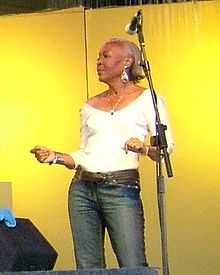Myrna Hague
| Myrna Hague | |
|---|---|
 Myrna Hague performing live, August 2007 | |
| Background information | |
| Genres | Jazz, lovers rock |
| Occupations | Singer |
| Instruments | Vocals |
| Years active | mid-1960s–present |
| Labels | Studio One |
| Associated acts | Sonny Bradshaw |
Myrna Hague, known as "Jamaica's First Lady of Jazz", is a Jamaican lovers rock and jazz singer and actress, who recorded for Coxsone Dodd's Studio One.
Biography
Hague's career began in the mid-1960s.[1] She performed at jazz venues in London and recorded for Studio One, notably the Melody Life album.[2] Melody Life included some of her most popular singles, including the title track, "How Could I Live", and "First Cut Is The Deepest".[3][4]
Hague is a member of the board of the Jamaica Cultural Development Commission (JCDC), and a former tutor at the Jamaica School of Music. She won the Caribbean Broadcasting Union Song Festival in 1990, and has won the Jamaica Music Industry Award for jazz several times as well as the Jamaica Federation of Musicians Award and Special Merit Award in 1993.[5] She is often referred to as "Jamaica's First Lady of Jazz".[1][6]
Hague founded the Ocho Rios Jazz Festival with her husband, jazz musician Sonny Bradshaw, and continues to organize the festival.[7][8][9]
In 2004, Hague was diagnosed with breast cancer, but after a long course of treatment made a full recovery.[1]
She has toured internationally, recently as guest vocalist with Jazz Jamaica, and as part of Women In Jazz and the Jamaica Big Band.[10][11][12]
In November 2012 she received a Caribbean Hall of Fame Award from the Caribbean Development for the Arts, Sports and Culture Foundation.[13]
Since 2011 she has held the annual 'Simply Myrna' concert series, and recordings from the first two years of the concerts were released in December 2012 on the album The Best of Simply Myrna Concerts Live.[14]
Discography
Singles
- "A Song I'd Like To Sing" (1970), Faze Four
- "Best Thing That Ever Happened"
- "First Cut Is The Deepest"
- "For All We Know"
- "How Could I Live"
- "Melody Life"
- "Never Never"
- "On A Clear Day" (1971), Faze Four
- "Our Day Will Come"
- "That's What Friends Are For"
- "Time After Time" (1971), Faze Four
- "Touch Me Baby" Studio One
- "What About Me" (1976), Studio One
- "What Colour Is Love"
- Honey EP (2012)
Albums
- Melody Life (1972), Studio One
- The Best of Simply Myrna Concerts Live (2012)
Compilation appearances
- "What About Me" on Feel Like Jumping (2000), Heartbeat
- "Touch Me Baby" on Studio One Lovers (2005), Soul Jazz
References
- ↑ 1.0 1.1 1.2 Olivia Leigh Campbell (2006), "Myrna Hague: Over the cancer trauma and searching - Ten questions for Myrna Hague", Jamaica Observer, 9 January 2006
- ↑ McDonald-Whyte, Novia (2008), "There's Something About Myrna", Jamaica Observer, 27 January 2008.
- ↑ Melody Life at Roots Archives
- ↑ Cooke, Mel (2011) "Myrna Hague Takes 'First Cut' Of Reggae", Jamaica Observer, 6 March 2011. Retrieved 22 December 2012
- ↑ Jamaica Observer, 8 December 2001.
- ↑ Reckord, Michael (2008), "JAZZ in abundance at Pegasus", Jamaica Gleaner, 12 June 2008.
- ↑ Gambrill, Tony (2007), "Sonny Bradshaw is 81 years young", Jamaica Observer, 27 May 2007.
- ↑ Edwards, Michael, "Jazzophonic" (2007), "Jazz First", Jamaica Observer, 11 March 2007.
- ↑ Johnson, Richard (2013) "'Ochi' Jazz Fest hits high note", Jamaica Observer, 20 June 2013. Retrieved 20 June 2013
- ↑ "LONDON JAZZ FESTIVAL: Jazz Jamaica with Ernest Ranglin/Marjorie Whylie/Myrna Hague + Abram Wilson/London Community Gospel Choir, Time Out London
- ↑ Walters, Basil (2008), "Women in Jazz open annual Ocho Rios Jazz Fest Sunday", Jamaica Observer, 4 June 2008.
- ↑ Walters, Basil (2008), "All set for Jazz on the Green February 17", Jamaica Observer, 14 February 2008.
- ↑ "PHOTO: Myrna Hague accepts", Jamaica Observer, 28 November 2012. Retrieved 1 December 2012
- ↑ Cooke, Mel (2012) "'Simply Myrna' Goes Live", Jamaica Gleaner, 24 December 2012. Retrieved 24 December 2012
External links
- Myrna Hague at Roots Archives
- Myrna Hague at Last.fm
- Edwards, Michael A. (2008), "Musical treats aplenty at Jazz on the Green", Jamaica Observer, 19 February 2008.